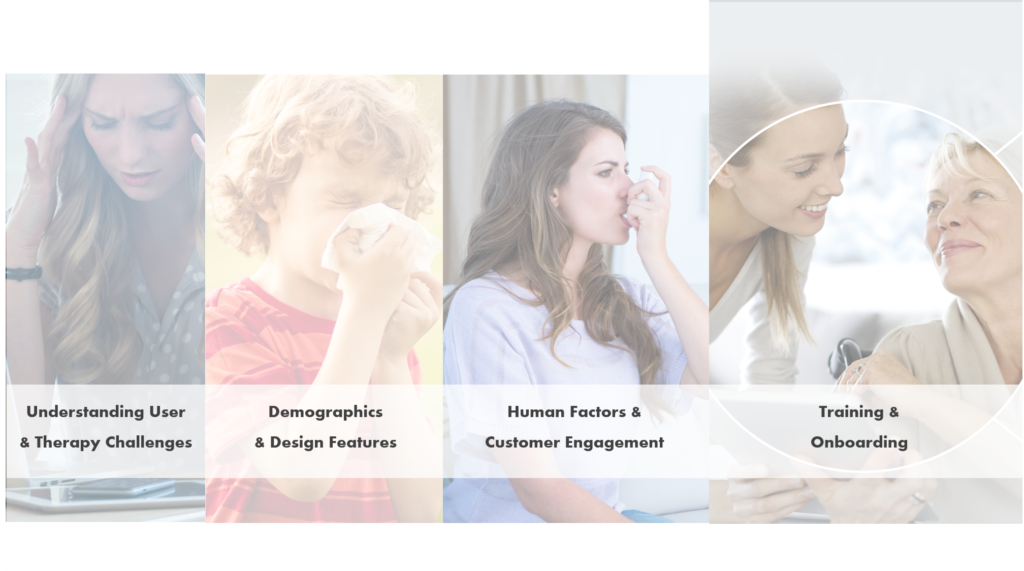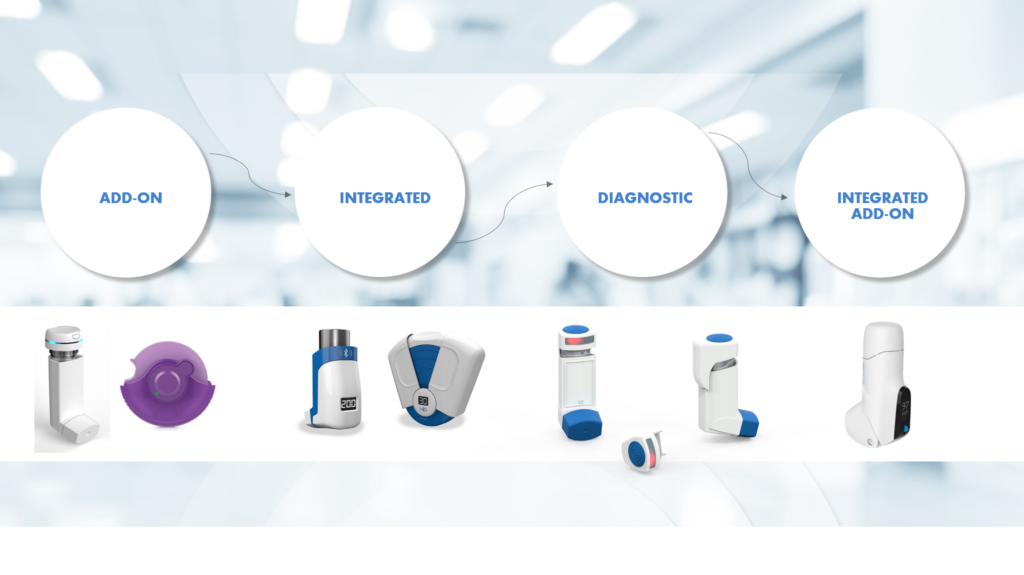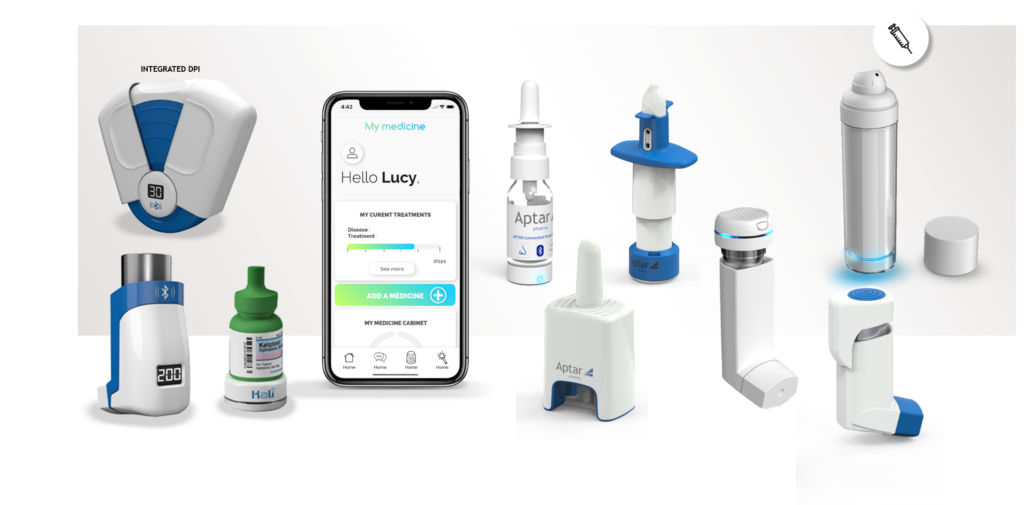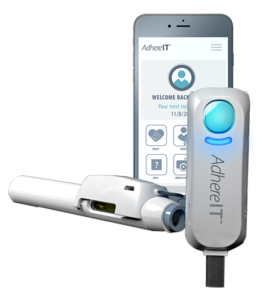Citation: Bates M, Koerner J, Praquin J, “The Current State of Play in Connected Devices”. ONdrugDelivery Magazine, Issue 103 (Dec 2019), pp 5-8.
Marcus Bates; Joachim Koerner and Jerôme Praquin discuss the current state of play, what connected device advocates are doing to enable faster implementation, and how we can optimise connected technology while reducing the cost and improving human factors.
The discussion around connectivity in drug delivery devices has been ongoing for some time now. And still, despite all the compelling evidence, we have yet to see any large-scale commercial launches for connected devices.
The initial focus for deploying connected devices was to improve adherence to prescribed drug dosing regimens. Some 60% of patients fail to take their medication properly – resulting in a significant impact on health outcomes and total healthcare spend. While this remains a focus and a growth area for connected devices in combination with digital platform solutions, adjacent benefit platforms have started to gain traction.
“When the concept of a digital health ecosystem was first introduced, along with the advent of connected devices, it was widely believed that implementation would be relatively rapid given the benefits to the entire supply chain.”
On-device training and diagnostic tools, remote patient monitoring, proximity alerts and emergency calls for rescue medications, electronic lock-out for scheduled drugs and heat mapping for public health initiatives, amongst others, are all gaining prominence. The bottom line is that a connected device can truly be a smart companion to improve outcomes for patients in terms of health, well-being and quality of life (Figure 1).

Figure 1: User-centric device design.
AN EVOLUTION IN CONNECTED DEVICES
When the concept of a digital health ecosystem was first introduced, along with the advent of connected devices, it was widely believed that implementation would be relatively rapid given the benefits to the entire supply chain – from patients to pharmaceutical companies, insurance companies, hospitals and care providers.
It was envisioned that we would have a homogeneous, feature-rich, fully integrated connected device, capturing all the relevant data and transmitting it to the right stakeholders with all the associated data analytics and insights, creating a seamless patient experience.
While this continues to be the ultimate goal, there have been several challenges. Evolving regulation relating to connected devices and digital health, a perception of increased costs, sustainability, slower than expected physician and payer buy-in, a lack of sufficient real-world evidence and a not-quite-so-seamless patient experience have all slowed progress. This has resulted in a somewhat fragmented approach to development and deployment of connected devices. But it isn’t necessarily all bad news. It essentially means there is now choice beyond the single ubiquitous device, providing options that can be assessed in the context of the drug and the therapy.
CHOOSE THE LEVEL OF COMPLEXITY YOU NEED
For initial product introduction and collection of real-world data, add-on devices have been preferred for several clinical studies – and for commercial launch, in some cases. Add-on devices do bring with them some clear benefits for pharma partners. By using US 510(k) or EU CE clearance, add-on devices offer a faster pathway to regulatory approval compared with drug-device combination product approval. And as the cost of the device can be amortised over multiple uses, the total acquisition cost can be lowered. But although add-on devices can be designed to be feature rich and easy to use, they still require the patient to take a few additional steps before administering the drug, thus increasing the number of steps in the patient workflow. This change to the workflow needs appropriate training and onboarding to ensure it creates an engaging experience for the patient.
The challenge with patient workflow and the number of patient interaction steps for add-on devices can be addressed with an integrated connected device. From a pharma perspective, being integrated into an existing device would also offer some potential options to extend and/or protect intellectual property rights. However, these benefits must be viewed in the context that these devices are really only suitable in a single use/single product setting, thus increasing the total cost of ownership while lowering the burden for the patient and thus potentially increasing the acceptance level.
A potential compromise could be a reusable integrated device that offers the workflow and interaction benefits of a fully integrated device, while providing a sustainable solution that is reusable and therefore better value over life. The downside could be slightly more complex development programmes, which would add upfront time and cost.
As connected devices evolve into smart companion tools, they are enabling additional diagnostic capabilities through a variety of sensors and algorithms (on-device and on the software platform). For example, flow sensor and microphone data during inhalation can be used as a surrogate measure to assess if there is a deterioration in lung function. While not immediately replacing existing standards for diagnosis, they provide another data point for patients and help them to better manage their health. Now, not only can devices capture patient data, they can also act as a training and diagnostic tool. This patient-centric training brings benefits to the patient – they feel more in control of their regimen – and it also delivers benefits to healthcare systems, for example, clinical staff can focus on priorities other than patient training.

Figure 2: Aptar’s portfolio of connected devices.
As each of the device connectivity options (summarised in Figure 2) offers a different value proposition – based on the customer, stakeholder and region – Aptar Pharma has developed a portfolio of products that offers variations on these options. For example, integrated connected metered-dose inhalers (MDIs) and dry-powder inhalers (DPIs), add-on devices for MDIs, add-on devices with flow sensors for MDIs, and integrated add-on breath-actuated inhalers (Figure 3). Each of these devices has a role to play, depending on factors such as where you are in the world. For example, in more price-sensitive markets in Asia, add-on devices have been a great way to create market engagement and gather real-world data to support broader adoption. In the US and EU, add-on devices have played a significant role in creating market awareness and now some are being transitioned to an integrated connected device.

Figure 3: The changing landscape of connected device options.
REDUCING COST, INCREASING ACCEPTANCE AND ACCELERATING IMPLEMENTATION
Aptar Pharma employs a single platform for most of its devices, which means reduced time-to-market and lower development costs. Leveraging the power of our experience across three industry segments in which we operate – pharma, beauty and home, and food and beverage – we have established strong relationships with front-runners in micro-electronics, giving us access to their R&D road maps for microprocessors and sensors, as well as competitive pricing. This exposure enables us to use the most optimum solutions, while ensuring security of supply. This commitment to partnership and shared learning between our business segments enables us to maximise cross-business developments such as our mobile application standard development kit (SDK) and device embedded software.
HUMAN FACTORS NEED TO BE AT THE CORE OF WHAT WE DO
“We need to focus on the key functional requirements and make the device as intuitive as possible.”
Whatever the therapy or device, the value must be real, and this can only be realised by seeing an improvement in patient health outcomes that leads directly to a reduction in outpatient care or inpatient treatments. We need to focus on the key functional requirements and make the device as intuitive as possible. Knowing that the patient demographic is very different from one disease to another, and recognising that every patient will have different expectations and capabilities around technology, means that human factors are critical in connected device design. Patients do not want the time to take medication to be longer or more onerous than it already is.

Figure 4: The AdhereIT platform from Noble, an Aptar Pharma company.
An example of an early-stage patient-centric approach is the AdhereIT platform (Figure 4) from Noble, an Aptar Pharma company, which is created specifically for use during the training and onboarding phase to gather detailed information before patients begin self-injecting with the real drug delivery device. This creates increased value for both patients and pharma by going beyond data gathering – such as whether or not a patient injected – to also providing insights such as whether the self-injection was a “wet injection” or whether it was performed correctly. Using this more accurate data helps pharma partners implement solutions to improve patient adherence. Connected devices help bridge the gap between these critical upfront periods in the patient treatment process. Without accurate data collected by connected devices such as AdhereIT, pharma partners rely heavily on self-reported patient data, which is often less accurate.
CONCLUSION
Today, patient adherence is at an unacceptably low level. With a greater proportion of the population suffering from chronic diseases such as asthma and chronic obstructive pulmonary disease (COPD) it therefore stands to reason that the number of people failing to follow their prescribed regimen will increase. Here technology really can support a significant shift in patient outcomes. As with all innovation, price is often the main barrier to early adoption. However, as with all innovation, technology is evolving, expertise is burgeoning, adoption is growing and costs are decreasing. Just look at the wearable market, where the number of connected wearable devices worldwide is expected to jump from 526 million in 2016 to more than 1.1 billion in 2022.
Aptar Pharma has developed a portfolio of connected devices that spans every delivery route from injectables to nasal to ophthalmics. With connectivity and digital health gaining further traction with all the key stakeholders – patients, pharma, payers and care providers – accelerated mass adoption of these solutions is set to happen soon.

